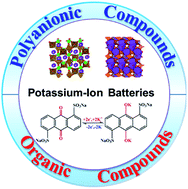Emerging polyanionic and organic compounds for high energy density, non-aqueous potassium-ion batteries
Abstract
Potassium ion batteries (PIBs) as promising energy storage candidates have attracted increasing attention due to the low-cost and abundant potassium resources. Despite numerous emerging electrode materials, the development of PIBs has consecutively encountered major challenges compared with lithium-ion batteries (LIBs) and sodium-ion batteries (SIBs), such as low reversible specific capacities, inferior cycling stabilities, and unsatisfactory energy densities. In light of this, we provide a state-of-the-art review on the development of emerging classes of cathode materials, especially for polyanionic composites and organic compounds, with the aim of achieving high energy density for non-aqueous PIBs. First of all, we highlight the recent development of electrode materials towards non-aqueous PIBs with the discussion on their existing problems and the potential solutions. Then, the recent advancements in polyanionic and organic compounds towards achieving high energy density of PIBs are provided. We focus on their structure–performance relationships with a comparison of their electrochemical properties, and further promising investigations of these types of cathode materials are identified and discussed as well. Finally, personal perspectives on future optimization on cathode materials towards realizing the real applications in PIBs are constructively discussed.

- This article is part of the themed collections: Journal of Materials Chemistry A Recent Review Articles and 2020 Journal of Materials Chemistry A most popular articles


 Please wait while we load your content...
Please wait while we load your content...